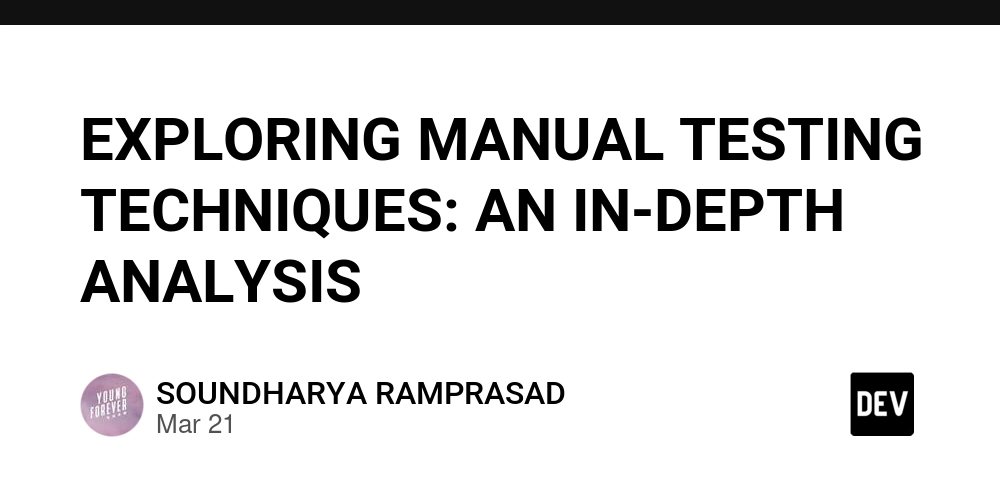EXPLORING MANUAL TESTING TECHNIQUES: AN IN-DEPTH ANALYSIS
EXPLORING MANUAL TESTING TECHNIQUES: AN IN-DEPTH ANALYSIS In the ever-evolving world of software development, testing plays a crucial role in ensuring that applications function as intended. As technology advances, testing methodologies also progress, with both manual and automated testing approaches remaining integral to the development cycle. Despite the rise of automation tools, manual testing remains essential, offering distinct advantages in certain scenarios. This blog explores some common manual testing techniques, including Boundary Value Analysis (BVA), Decision Table Testing, and the future of manual testing in the age of Artificial Intelligence (AI). COMMON MANUAL TESTING TECHNIQUES Manual testing refers to the process of manually checking software for defects or issues by executing test cases without the use of automation tools. Although automation has gained significant traction in recent years, manual testing continues to be indispensable for various reasons, such as flexibility, the ability to identify UX/UI issues, and handling complex scenarios that may require human judgment. Below are some of the common techniques used in manual testing: a. Exploratory Testing Exploratory testing is an unscripted testing technique that allows testers to explore the application without predefined test cases. It encourages testers to use their knowledge, experience, and creativity to uncover potential defects or issues. This type of testing is highly beneficial in situations where test cases are hard to define or when testers need to assess the overall usability and functionality of an application. b. Ad-hoc Testing Ad-hoc testing is similar to exploratory testing, but it involves no formal planning or documentation. It relies entirely on the tester’s intuition and understanding of the system. Ad-hoc testing is typically conducted when there’s a need to quickly assess the system in an informal, random manner, often to find defects that might be overlooked in more structured test plans. c. Regression Testing Regression testing ensures that new changes or features do not negatively impact the existing functionality of the software. It involves executing previously run test cases to verify that new updates have not introduced any new bugs or broken any existing features. Manual regression testing is commonly employed when automation is not feasible or when a smaller, more focused set of tests is required. d. Usability Testing Usability testing focuses on evaluating how user-friendly and intuitive the application is. Testers manually assess the system from the end user’s perspective, ensuring that it is easy to navigate, aesthetically pleasing, and functions in an intuitive manner. This technique is crucial for applications with a heavy focus on user experience. e. Smoke Testing Smoke testing involves performing a basic check on the system to see if the core functionalities work after a build or update. It’s a quick and superficial testing technique conducted to determine whether the software build is stable enough to undergo more detailed testing. This test is often performed manually in early stages of development. f. Sanity Testing Sanity testing is similar to smoke testing but focuses on a narrower scope. It checks if a particular functionality works as expected after a minor change or bug fix. The purpose of sanity testing is to ensure that the specific area of the system functions correctly without investigating other areas in detail. BOUNDARY VALUE ANALYSIS (BVA) Boundary Value Analysis is a popular testing technique used to identify defects at the boundaries of input values. The idea behind BVA is simple—most errors tend to occur at the boundaries of input ranges. This technique involves testing the values at the edges of input limits, just inside and just outside these boundaries, as well as the exact boundary values themselves. Key Principles of BVA Valid Boundaries: Test cases are designed to focus on the valid input range, which is the acceptable input range of a variable. Invalid Boundaries: It also tests inputs just outside of the valid boundary to see how the system handles invalid inputs. For instance, consider a field that accepts numbers between 10 and 20. In BVA, we would create test cases for the following values: Just below the lower limit: 9 Lower limit: 10 Just above the lower limit: 11 Just below the upper limit: 19 Upper limit: 20 Just above the upper limit: 21 By testing these boundaries, BVA ensures that the software handles edge cases effectively, preventing errors from occurring at the limits of input. Why Boundary Value Analysis is Effective BVA helps reduce the number of test cases needed to thoroughly test the boundaries of input values. Given that a substantial number of software defects occur near boundary values, this technique helps testers focus their efforts on high-risk areas. DECISION TABLE TESTING Decision Table Testing is a methodical testing t

EXPLORING MANUAL TESTING TECHNIQUES: AN IN-DEPTH ANALYSIS
In the ever-evolving world of software development, testing plays a crucial role in ensuring that applications function as intended. As technology advances, testing methodologies also progress, with both manual and automated testing approaches remaining integral to the development cycle. Despite the rise of automation tools, manual testing remains essential, offering distinct advantages in certain scenarios. This blog explores some common manual testing techniques, including Boundary Value Analysis (BVA), Decision Table Testing, and the future of manual testing in the age of Artificial Intelligence (AI).
- COMMON MANUAL TESTING TECHNIQUES
Manual testing refers to the process of manually checking software for defects or issues by executing test cases without the use of automation tools. Although automation has gained significant traction in recent years, manual testing continues to be indispensable for various reasons, such as flexibility, the ability to identify UX/UI issues, and handling complex scenarios that may require human judgment. Below are some of the common techniques used in manual testing:
a. Exploratory Testing
Exploratory testing is an unscripted testing technique that allows testers to explore the application without predefined test cases. It encourages testers to use their knowledge, experience, and creativity to uncover potential defects or issues. This type of testing is highly beneficial in situations where test cases are hard to define or when testers need to assess the overall usability and functionality of an application.
b. Ad-hoc Testing
Ad-hoc testing is similar to exploratory testing, but it involves no formal planning or documentation. It relies entirely on the tester’s intuition and understanding of the system. Ad-hoc testing is typically conducted when there’s a need to quickly assess the system in an informal, random manner, often to find defects that might be overlooked in more structured test plans.
c. Regression Testing
Regression testing ensures that new changes or features do not negatively impact the existing functionality of the software. It involves executing previously run test cases to verify that new updates have not introduced any new bugs or broken any existing features. Manual regression testing is commonly employed when automation is not feasible or when a smaller, more focused set of tests is required.
d. Usability Testing
Usability testing focuses on evaluating how user-friendly and intuitive the application is. Testers manually assess the system from the end user’s perspective, ensuring that it is easy to navigate, aesthetically pleasing, and functions in an intuitive manner. This technique is crucial for applications with a heavy focus on user experience.
e. Smoke Testing
Smoke testing involves performing a basic check on the system to see if the core functionalities work after a build or update. It’s a quick and superficial testing technique conducted to determine whether the software build is stable enough to undergo more detailed testing. This test is often performed manually in early stages of development.
f. Sanity Testing
Sanity testing is similar to smoke testing but focuses on a narrower scope. It checks if a particular functionality works as expected after a minor change or bug fix. The purpose of sanity testing is to ensure that the specific area of the system functions correctly without investigating other areas in detail.
- BOUNDARY VALUE ANALYSIS (BVA)
Boundary Value Analysis is a popular testing technique used to identify defects at the boundaries of input values. The idea behind BVA is simple—most errors tend to occur at the boundaries of input ranges. This technique involves testing the values at the edges of input limits, just inside and just outside these boundaries, as well as the exact boundary values themselves.
Key Principles of BVA
Valid Boundaries: Test cases are designed to focus on the valid input range, which is the acceptable input range of a variable.
Invalid Boundaries: It also tests inputs just outside of the valid boundary to see how the system handles invalid inputs.
For instance, consider a field that accepts numbers between 10 and 20. In BVA, we would create test cases for the following values:
- Just below the lower limit: 9
- Lower limit: 10
- Just above the lower limit: 11
- Just below the upper limit: 19
- Upper limit: 20
- Just above the upper limit: 21
By testing these boundaries, BVA ensures that the software handles edge cases effectively, preventing errors from occurring at the limits of input.
Why Boundary Value Analysis is Effective
BVA helps reduce the number of test cases needed to thoroughly test the boundaries of input values. Given that a substantial number of software defects occur near boundary values, this technique helps testers focus their efforts on high-risk areas.
- DECISION TABLE TESTING
Decision Table Testing is a methodical testing technique used to represent and examine various combinations of conditions and actions in a system. This technique is particularly useful when dealing with complex business logic, where multiple conditions result in different outcomes or actions.
How Decision Table Testing Works
A decision table consists of four quadrants:
- Conditions: The different inputs or conditions that need to be tested.
- Actions: The actions that the system should take in response to these conditions.
- Rules: The different combinations of conditions and the corresponding actions to be tested.
- Outcome: The expected results based on the rules.
A decision table organizes the possible combinations of inputs (conditions) and their corresponding actions, making it easier for testers to ensure comprehensive test coverage. Each combination is tested to verify that the system performs as expected.
Example of a Decision Table
Consider a loan approval system where the following conditions are checked:
- Credit score (low, medium, high)
- Age (under 18, 18-30, over 30)
- Income level (low, medium, high)
A decision table would list all possible combinations of these conditions and their corresponding actions, like granting approval or rejection based on the criteria.
Decision Table Testing ensures all possible combinations of conditions are tested, helping to avoid logical errors in the system.
- THE FUTURE OF MANUAL TESTING IN THE AGE OF AI
As the software industry continues to embrace automation and Artificial Intelligence (AI), many may wonder about the future of manual testing. While AI has revolutionized many aspects of software development, manual testing still plays an irreplaceable role in certain areas, and its relevance will continue for the foreseeable future.
AI in Testing: What’s Changing?
AI has the potential to enhance testing in several ways, such as:
- Automated Test Generation: AI tools can automatically generate test cases based on user stories and requirements, reducing the manual effort involved in test creation.
- Self-healing Tests: AI can help identify and repair broken tests due to UI changes, improving the robustness of automated testing frameworks.
- Predictive Analytics: AI can analyze past testing data to predict the most likely failure points in an application, helping testers focus on critical areas.
Despite these advancements, AI-powered tools are not flawless. They require large datasets and continuous training to improve accuracy. Furthermore, while AI can handle repetitive tasks like regression testing or performance testing, it still lacks the creativity and adaptability that human testers bring.
Why Manual Testing Will Persist
Manual testing is crucial for tasks that require human judgment, creativity, and understanding of complex, real-world scenarios. Some areas where manual testing will continue to thrive include:
- User Experience (UX) and Usability Testing: Evaluating how intuitive, accessible, and satisfying an application is to use is a subjective task that requires human testers.
- Exploratory Testing: AI may not be able to replicate the flexibility and intuition of a skilled tester who explores the software and uncovers defects through trial and error.
- Ethical and Social Implications: Human testers are better equipped to evaluate the societal and ethical implications of an application, such as fairness, bias, or inclusivity.
THE HYBRID FUTURE
The future of testing lies in a hybrid approach where AI tools complement manual testing. AI can automate repetitive tasks and handle large volumes of data, while manual testers focus on high-risk, creative, and subjective aspects of testing. As AI tools evolve, the relationship between human testers and AI will become more collaborative, leading to a more efficient and effective testing process.
CONCLUSION
Manual testing remains a vital part of the software development lifecycle, offering insights that automated tools alone cannot provide. Techniques such as Boundary Value Analysis and Decision Table Testing ensure that edge cases and complex business logic are thoroughly tested. While the rise of AI is undoubtedly transforming the field of software testing, human testers will continue to play an essential role in ensuring the quality, usability, and ethical integrity of software systems. The future of testing lies in a symbiotic relationship between AI and manual testing, where each complements the other to create a more robust and efficient testing process.











































































































































































![[The AI Show Episode 142]: ChatGPT’s New Image Generator, Studio Ghibli Craze and Backlash, Gemini 2.5, OpenAI Academy, 4o Updates, Vibe Marketing & xAI Acquires X](https://www.marketingaiinstitute.com/hubfs/ep%20142%20cover.png)




























































































































![[DEALS] The Premium Learn to Code Certification Bundle (97% off) & Other Deals Up To 98% Off – Offers End Soon!](https://www.javacodegeeks.com/wp-content/uploads/2012/12/jcg-logo.jpg)


![From drop-out to software architect with Jason Lengstorf [Podcast #167]](https://cdn.hashnode.com/res/hashnode/image/upload/v1743796461357/f3d19cd7-e6f5-4d7c-8bfc-eb974bc8da68.png?#)








































































































.png?#)























.webp?#)










_Christophe_Coat_Alamy.jpg?#)
 (1).webp?#)




































































































![Apple Considers Delaying Smart Home Hub Until 2026 [Gurman]](https://www.iclarified.com/images/news/96946/96946/96946-640.jpg)
![iPhone 17 Pro Won't Feature Two-Toned Back [Gurman]](https://www.iclarified.com/images/news/96944/96944/96944-640.jpg)
![Tariffs Threaten Apple's $999 iPhone Price Point in the U.S. [Gurman]](https://www.iclarified.com/images/news/96943/96943/96943-640.jpg)



































































































































